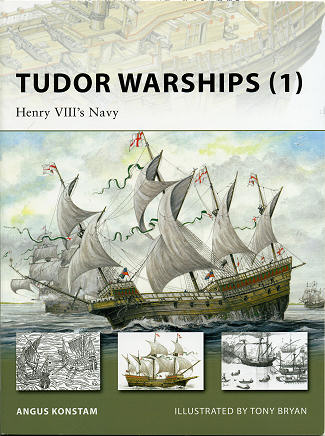 To
most of us, the age of sail brings up images of majestic ships under full sail
and bristling with guns; each blasting broadsides at enemy ships with the scene
full of shattering masts and clouds of smoke. This would be true of the 17th,
18th and early 19th century, but these sorts of ships had to be developed from
something else. All of that harkens back to the late 15th and early 16th century
in general, and the reign of the Tudor kings of England in particular.
To
most of us, the age of sail brings up images of majestic ships under full sail
and bristling with guns; each blasting broadsides at enemy ships with the scene
full of shattering masts and clouds of smoke. This would be true of the 17th,
18th and early 19th century, but these sorts of ships had to be developed from
something else. All of that harkens back to the late 15th and early 16th century
in general, and the reign of the Tudor kings of England in particular.
Before the reign of Henry VII and Henry VIII the Navy Royal
had very few ships. No more than a handful at any one time and most of the quite
small. It was the fear of invasion by the French that spurred Henry VII and
later his son to produce larger and larger ships. While still not numbering more
than a handful or two, these ships displayed a large number of weapons on both
forecastle and sterncastle, though most were small and designed as
anti-personnel weapons to rake the decks of the opposing ship.
Henry decided to start arming the larger ships with a few
larger cannon. These weapons were not light and in order to prevent the ships
from being too top heavy, started placing them on lower decks, requiring gun
ports to be cut into the sides of the ships. These weapons were very much one
shot wonders if they were muzzle-loaders, as there was no room to pull back the
guns to reload them. This glitch in the design of ships was later fixed, but by
the end of the reign of Henry VIII, it was still a problem.
We can thank Henry VIII for his fascination with ship's guns
for developing fighting ships with large weapons. Initially these were only to
be used to assist landing troops as sort of a floating artillery, but later it
was found that these guns would do great damage to enemy ships and if it could
be done from a greater range than right next to each other, then so much the
better.
Angus Konstam tells the story of these interesting ships,
taking you through the design and development of all the ships of the Navy Royal
during this time period. Much of what has been learned about these ships is
fairly recent, helped by the discovery and examination of one of Henry's largest
ships, the Mary Rose (as shown on the book cover). This unfortunate ship
was sunk, not in war, but when a strong wind caused the ship to lean too far
over, causing water to enter the lower gun ports. This eventually led to the
rapid sinking of the ship with the loss of most hands.
All of this is backed by superb images of period
illustrations and the artwork of Tony Bryan, providing one
with an outstanding book on a truly unique subject. Get this one, you'll be
pleased you did.
April 2008
For more on the complete line of Osprey books,
visit www.ospreypublishing.com. In the US, it is
Osprey Direct at 44-02 23rd St, Suite 219, Long Island City, NY 11101., where you can
get a catalogue of available books.
If you would like your product reviewed fairly and quickly, please contact
me or see other details in the Note to
Contributors.
 To
most of us, the age of sail brings up images of majestic ships under full sail
and bristling with guns; each blasting broadsides at enemy ships with the scene
full of shattering masts and clouds of smoke. This would be true of the 17th,
18th and early 19th century, but these sorts of ships had to be developed from
something else. All of that harkens back to the late 15th and early 16th century
in general, and the reign of the Tudor kings of England in particular.
To
most of us, the age of sail brings up images of majestic ships under full sail
and bristling with guns; each blasting broadsides at enemy ships with the scene
full of shattering masts and clouds of smoke. This would be true of the 17th,
18th and early 19th century, but these sorts of ships had to be developed from
something else. All of that harkens back to the late 15th and early 16th century
in general, and the reign of the Tudor kings of England in particular.